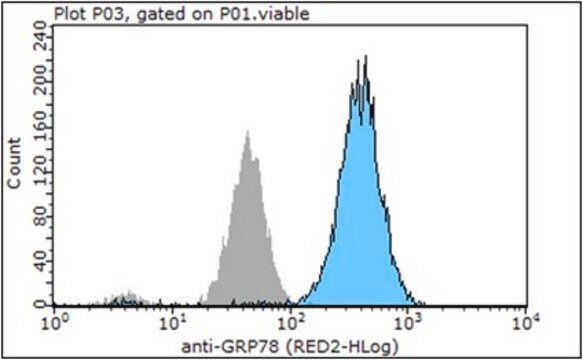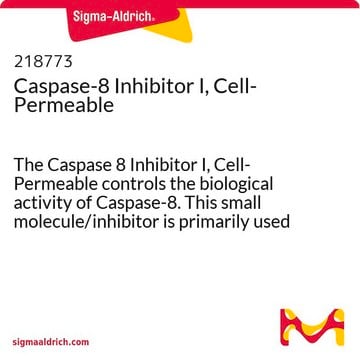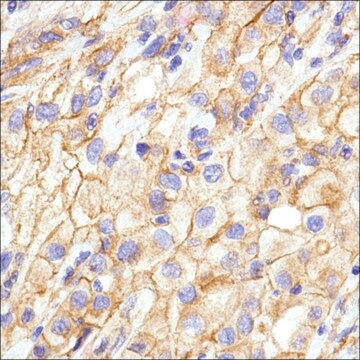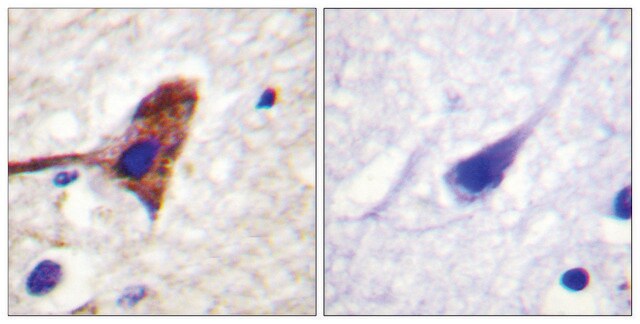MABS1911
Anti-Serpin B9 Antibody, clone 7D8
clone 7D8, from mouse
Synonym(s):
Cytoplasmic antiproteinase 3, CAP-3, CAP3, Peptidase inhibitor 9, PI-9
About This Item
Recommended Products
biological source
mouse
Quality Level
antibody form
purified immunoglobulin
antibody product type
primary antibodies
clone
7D8, monoclonal
species reactivity
human
packaging
antibody small pack of 25 μL
technique(s)
ELISA: suitable
flow cytometry: suitable
immunocytochemistry: suitable
immunofluorescence: suitable
immunohistochemistry: suitable (paraffin)
western blot: suitable
isotype
IgG1κ
NCBI accession no.
UniProt accession no.
target post-translational modification
unmodified
Gene Information
human ... SERPINB9(5272)
General description
Specificity
Immunogen
Application
Flow Cytometry Analysis: A representative lot detected Serpin B9 in Flow Cytometry applications (Hirst, C.E., et. al. (2003). J Immunol. 170(2):805-15).
Immunocytochemistry Analysis: A representative lot detected Serpin B9 in Immunocytochemistry applications (Hirst, C.E., et. al. (2003). J Immunol. 170(2):805-15).
Immunofluorescence Analysis: A representative lot detected Serpin B9 in Immunofluorescence applications (Hirst, C.E., et. al. (2003). J Immunol. 170(2):805-15).
Immunohistochemistry Analysis: A representative lot detected Serpin B9 in Immunohistochemistry applications (Hirst, C.E., et. al. (2001). Mol Hum Peprod. 7(12):1133-42).
Western Blotting Analysis: A 1:100 dilution from a representative lot detected Serpin B9 in YT and Jurkat cell lysates (Courtesy of Prof. Phillip Bird, Ph.D., Monash University, Victoria Australia).
Western Blotting Analysis: A representative lot detected Serpin B9 in Western Blotting applications (Hirst, C.E., et. al. (2001). Mol Hum Peprod. 7(12):1133-42; Hirst, C.E., et. al. (2003). J Immunol. 170(2):805-15; Mangan, M.S., et. al. (2015). J Biol Chem. 291(7):3626-38).
Immunocytochemistry Analysis: A representative lot detected Serpin B9 in COS-1 cells (Courtesy of Prof. Phillip Bird, Ph.D., Monash University, Victoria Australia).
Inflammation & Immunology
Quality
Immunohistochemistry Analysis: A 1:50 dilution of this antibody detected Serpin B9 in human spleen tissue sections.
Target description
Physical form
Storage and Stability
Other Notes
Disclaimer
Not finding the right product?
Try our Product Selector Tool.
Storage Class
12 - Non Combustible Liquids
wgk_germany
WGK 1
flash_point_f
Not applicable
flash_point_c
Not applicable
Certificates of Analysis (COA)
Search for Certificates of Analysis (COA) by entering the products Lot/Batch Number. Lot and Batch Numbers can be found on a product’s label following the words ‘Lot’ or ‘Batch’.
Already Own This Product?
Find documentation for the products that you have recently purchased in the Document Library.
Our team of scientists has experience in all areas of research including Life Science, Material Science, Chemical Synthesis, Chromatography, Analytical and many others.
Contact Technical Service








